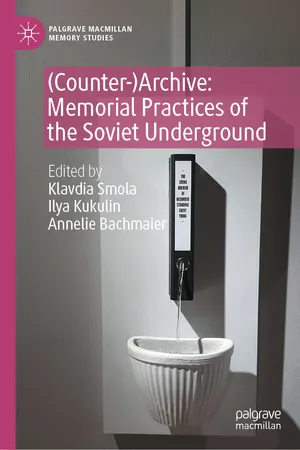
(Counter-)Archive: Memorial Practices of the Soviet Underground
- English
- ePUB (mobile friendly)
- Available on iOS & Android
(Counter-)Archive: Memorial Practices of the Soviet Underground
About this book
This book is the first major study exploring archival and memorial practices of the Soviet unofficial culture. The creation of counter-archives was one of the most important forms of cultural resistance in the Soviet Union. Unofficial artists and poets had to reinvent the possibilities of maintaining art and literature that "did not exist". Against the background of archival theories and memory studies, the volume explores how the culture of the Soviet underground has become one of the most striking cases of scholarly and artistic (self-)archiving, which – although being half-isolated from the outer world – reflected intellectual and artistic trends characteristic of its time. The guiding question of the volume is how Soviet unofficial culture (de)constructed social memory by collecting, archiving and memorizing tabooed culture of the past and present.
Frequently asked questions
- Essential is ideal for learners and professionals who enjoy exploring a wide range of subjects. Access the Essential Library with 800,000+ trusted titles and best-sellers across business, personal growth, and the humanities. Includes unlimited reading time and Standard Read Aloud voice.
- Complete: Perfect for advanced learners and researchers needing full, unrestricted access. Unlock 1.4M+ books across hundreds of subjects, including academic and specialized titles. The Complete Plan also includes advanced features like Premium Read Aloud and Research Assistant.
Please note we cannot support devices running on iOS 13 and Android 7 or earlier. Learn more about using the app.
Information
Table of contents
- Cover
- Front Matter
- 1. (Counter-)Archive: Memorial Practices of the Soviet Underground. Introduction
- Part I. Archiving Subcultures
- Part II. Archival Aesthetics and Poetics
- Part III. Artists as Collectors, Philologists, and Cultural Historians
- Part IV. The Afterlife of Memory
- Part V. Artistic Testimonies
- Back Matter